Diversity in Social Workplace
VerifiedAdded on 2023/01/19
|12
|2874
|85
AI Summary
This article discusses the concept of diversity in social workplace and its impact on the Indian cultural group in Australia. It provides a historical context of the Indian cultural group, their migration to Australia, and the demographics of the group. It also explores how this group became marginalized and what continues to perpetuate their marginalization in Australian society. The article concludes by discussing the anti-discriminatory and anti-oppressive approaches towards such groups and how social work professionals can assist in working with them.
Contribute Materials
Your contribution can guide someone’s learning journey. Share your
documents today.
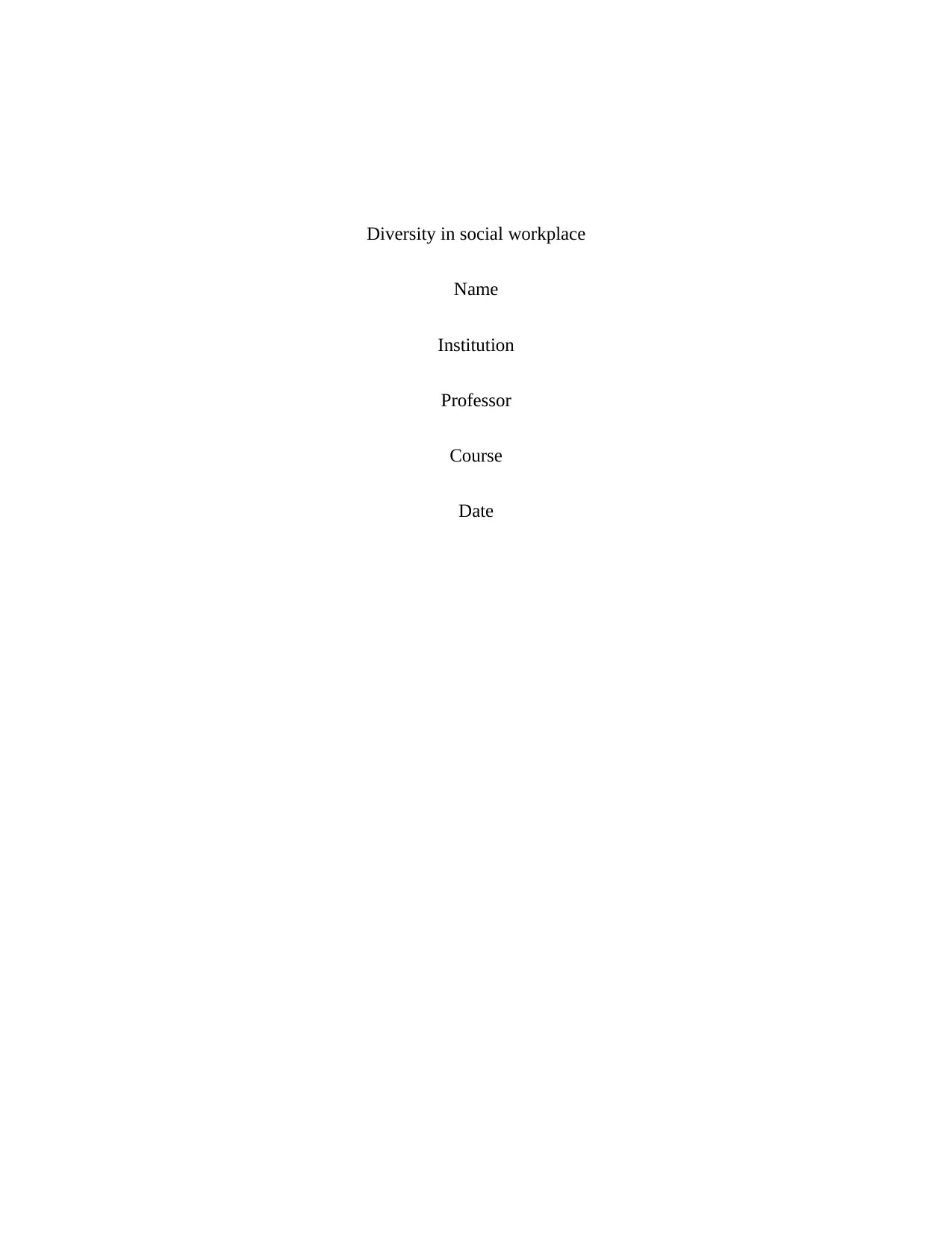
Diversity in social workplace
Name
Institution
Professor
Course
Date
Name
Institution
Professor
Course
Date
Secure Best Marks with AI Grader
Need help grading? Try our AI Grader for instant feedback on your assignments.
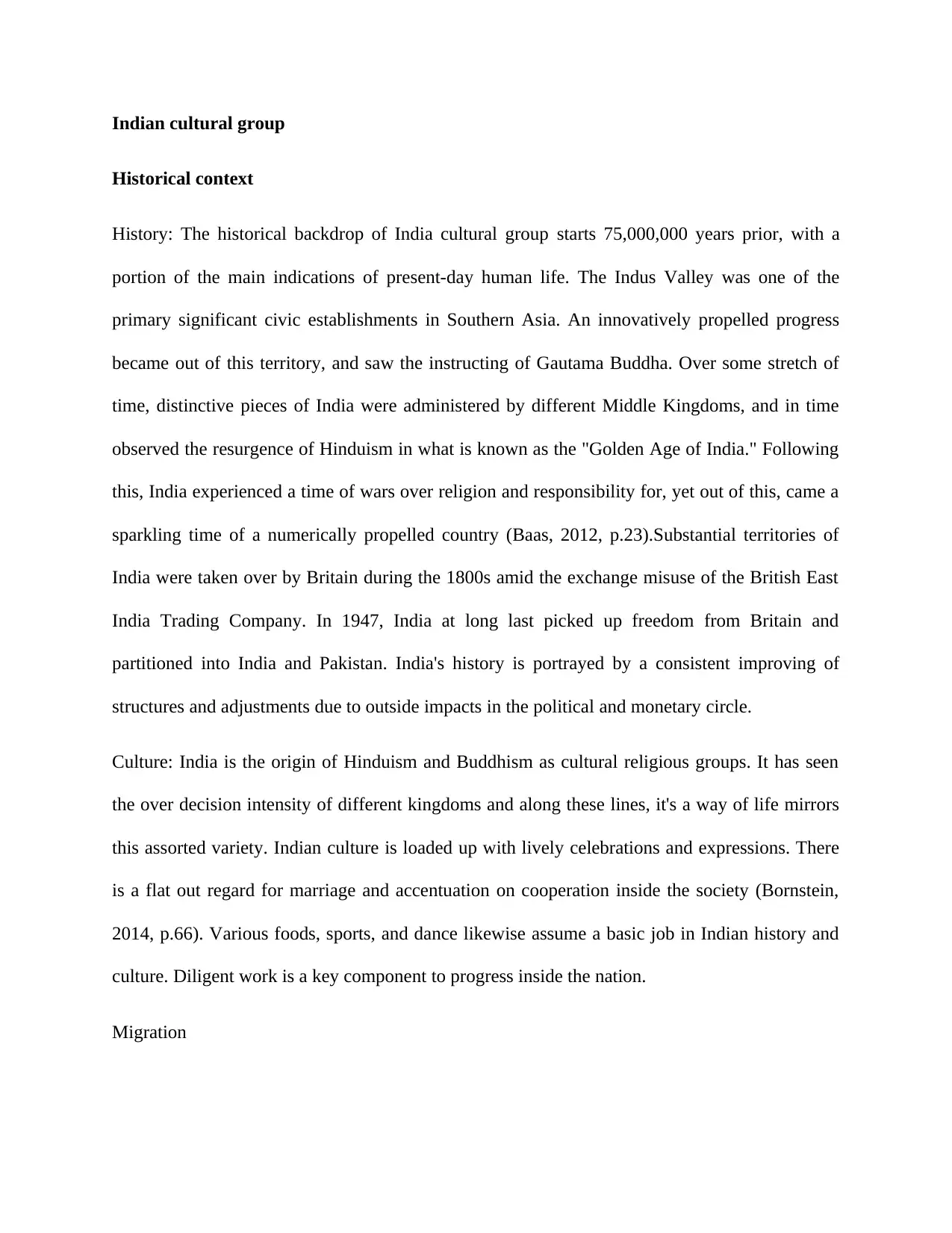
Indian cultural group
Historical context
History: The historical backdrop of India cultural group starts 75,000,000 years prior, with a
portion of the main indications of present-day human life. The Indus Valley was one of the
primary significant civic establishments in Southern Asia. An innovatively propelled progress
became out of this territory, and saw the instructing of Gautama Buddha. Over some stretch of
time, distinctive pieces of India were administered by different Middle Kingdoms, and in time
observed the resurgence of Hinduism in what is known as the "Golden Age of India." Following
this, India experienced a time of wars over religion and responsibility for, yet out of this, came a
sparkling time of a numerically propelled country (Baas, 2012, p.23).Substantial territories of
India were taken over by Britain during the 1800s amid the exchange misuse of the British East
India Trading Company. In 1947, India at long last picked up freedom from Britain and
partitioned into India and Pakistan. India's history is portrayed by a consistent improving of
structures and adjustments due to outside impacts in the political and monetary circle.
Culture: India is the origin of Hinduism and Buddhism as cultural religious groups. It has seen
the over decision intensity of different kingdoms and along these lines, it's a way of life mirrors
this assorted variety. Indian culture is loaded up with lively celebrations and expressions. There
is a flat out regard for marriage and accentuation on cooperation inside the society (Bornstein,
2014, p.66). Various foods, sports, and dance likewise assume a basic job in Indian history and
culture. Diligent work is a key component to progress inside the nation.
Migration
Historical context
History: The historical backdrop of India cultural group starts 75,000,000 years prior, with a
portion of the main indications of present-day human life. The Indus Valley was one of the
primary significant civic establishments in Southern Asia. An innovatively propelled progress
became out of this territory, and saw the instructing of Gautama Buddha. Over some stretch of
time, distinctive pieces of India were administered by different Middle Kingdoms, and in time
observed the resurgence of Hinduism in what is known as the "Golden Age of India." Following
this, India experienced a time of wars over religion and responsibility for, yet out of this, came a
sparkling time of a numerically propelled country (Baas, 2012, p.23).Substantial territories of
India were taken over by Britain during the 1800s amid the exchange misuse of the British East
India Trading Company. In 1947, India at long last picked up freedom from Britain and
partitioned into India and Pakistan. India's history is portrayed by a consistent improving of
structures and adjustments due to outside impacts in the political and monetary circle.
Culture: India is the origin of Hinduism and Buddhism as cultural religious groups. It has seen
the over decision intensity of different kingdoms and along these lines, it's a way of life mirrors
this assorted variety. Indian culture is loaded up with lively celebrations and expressions. There
is a flat out regard for marriage and accentuation on cooperation inside the society (Bornstein,
2014, p.66). Various foods, sports, and dance likewise assume a basic job in Indian history and
culture. Diligent work is a key component to progress inside the nation.
Migration
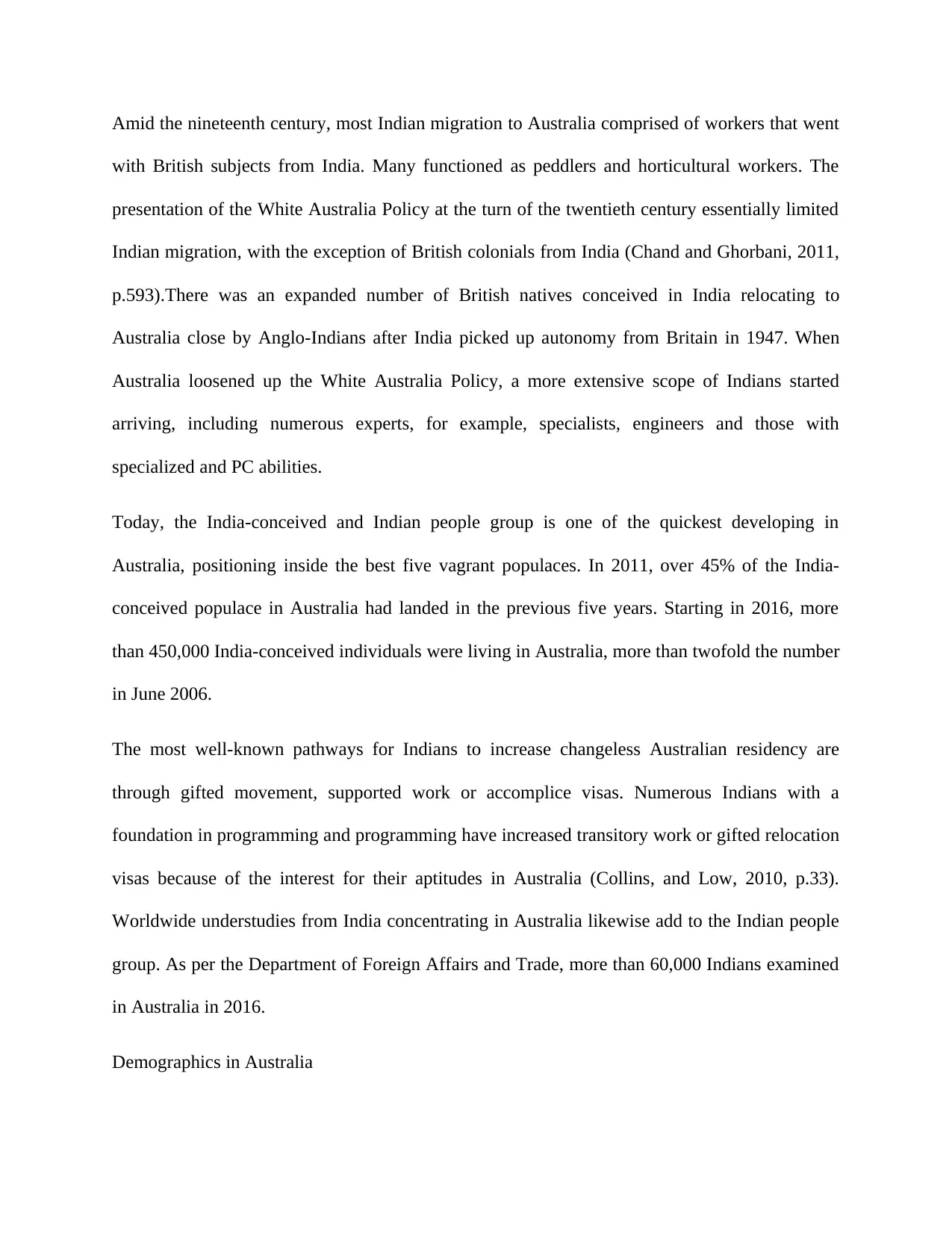
Amid the nineteenth century, most Indian migration to Australia comprised of workers that went
with British subjects from India. Many functioned as peddlers and horticultural workers. The
presentation of the White Australia Policy at the turn of the twentieth century essentially limited
Indian migration, with the exception of British colonials from India (Chand and Ghorbani, 2011,
p.593).There was an expanded number of British natives conceived in India relocating to
Australia close by Anglo-Indians after India picked up autonomy from Britain in 1947. When
Australia loosened up the White Australia Policy, a more extensive scope of Indians started
arriving, including numerous experts, for example, specialists, engineers and those with
specialized and PC abilities.
Today, the India-conceived and Indian people group is one of the quickest developing in
Australia, positioning inside the best five vagrant populaces. In 2011, over 45% of the India-
conceived populace in Australia had landed in the previous five years. Starting in 2016, more
than 450,000 India-conceived individuals were living in Australia, more than twofold the number
in June 2006.
The most well-known pathways for Indians to increase changeless Australian residency are
through gifted movement, supported work or accomplice visas. Numerous Indians with a
foundation in programming and programming have increased transitory work or gifted relocation
visas because of the interest for their aptitudes in Australia (Collins, and Low, 2010, p.33).
Worldwide understudies from India concentrating in Australia likewise add to the Indian people
group. As per the Department of Foreign Affairs and Trade, more than 60,000 Indians examined
in Australia in 2016.
Demographics in Australia
with British subjects from India. Many functioned as peddlers and horticultural workers. The
presentation of the White Australia Policy at the turn of the twentieth century essentially limited
Indian migration, with the exception of British colonials from India (Chand and Ghorbani, 2011,
p.593).There was an expanded number of British natives conceived in India relocating to
Australia close by Anglo-Indians after India picked up autonomy from Britain in 1947. When
Australia loosened up the White Australia Policy, a more extensive scope of Indians started
arriving, including numerous experts, for example, specialists, engineers and those with
specialized and PC abilities.
Today, the India-conceived and Indian people group is one of the quickest developing in
Australia, positioning inside the best five vagrant populaces. In 2011, over 45% of the India-
conceived populace in Australia had landed in the previous five years. Starting in 2016, more
than 450,000 India-conceived individuals were living in Australia, more than twofold the number
in June 2006.
The most well-known pathways for Indians to increase changeless Australian residency are
through gifted movement, supported work or accomplice visas. Numerous Indians with a
foundation in programming and programming have increased transitory work or gifted relocation
visas because of the interest for their aptitudes in Australia (Collins, and Low, 2010, p.33).
Worldwide understudies from India concentrating in Australia likewise add to the Indian people
group. As per the Department of Foreign Affairs and Trade, more than 60,000 Indians examined
in Australia in 2016.
Demographics in Australia
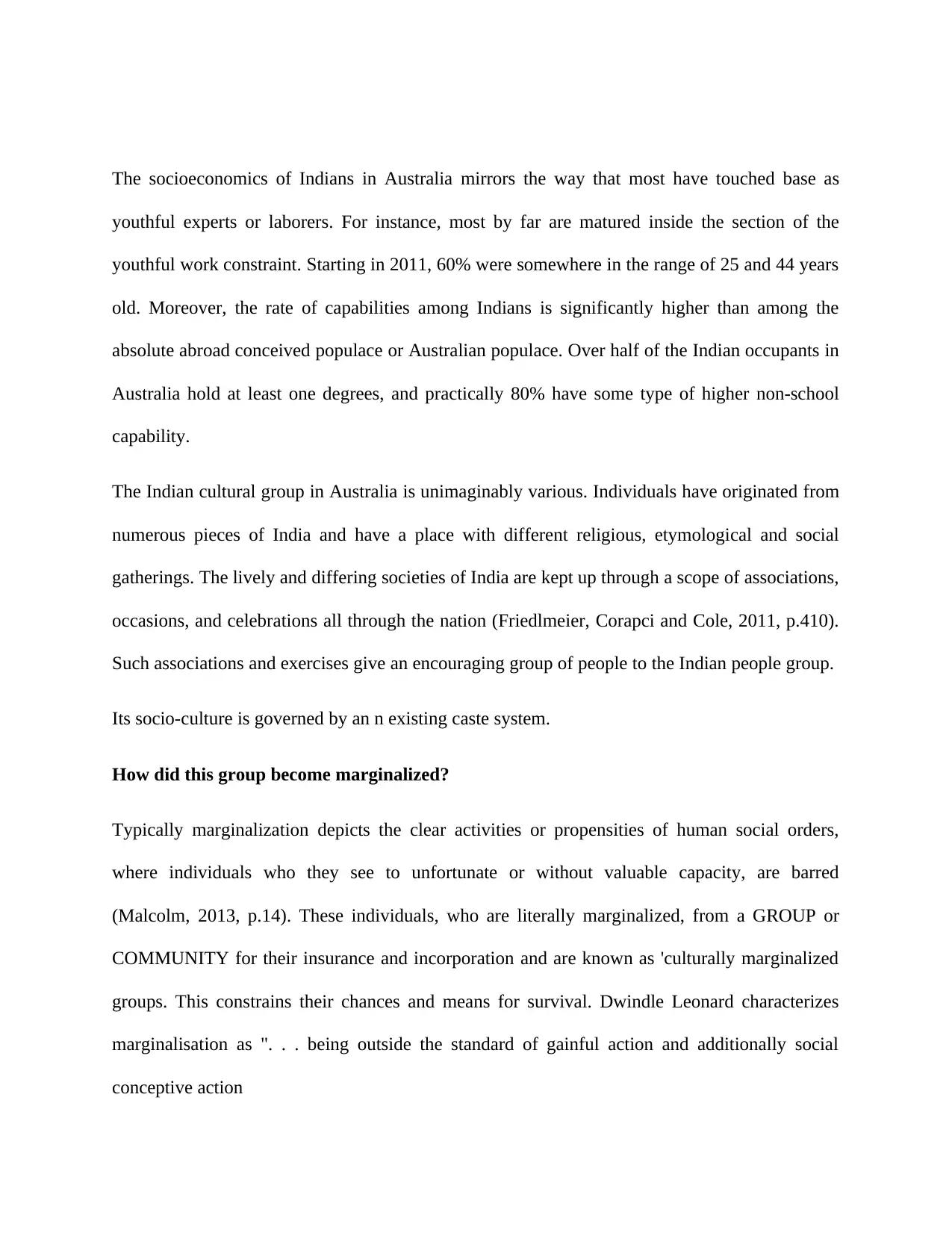
The socioeconomics of Indians in Australia mirrors the way that most have touched base as
youthful experts or laborers. For instance, most by far are matured inside the section of the
youthful work constraint. Starting in 2011, 60% were somewhere in the range of 25 and 44 years
old. Moreover, the rate of capabilities among Indians is significantly higher than among the
absolute abroad conceived populace or Australian populace. Over half of the Indian occupants in
Australia hold at least one degrees, and practically 80% have some type of higher non-school
capability.
The Indian cultural group in Australia is unimaginably various. Individuals have originated from
numerous pieces of India and have a place with different religious, etymological and social
gatherings. The lively and differing societies of India are kept up through a scope of associations,
occasions, and celebrations all through the nation (Friedlmeier, Corapci and Cole, 2011, p.410).
Such associations and exercises give an encouraging group of people to the Indian people group.
Its socio-culture is governed by an n existing caste system.
How did this group become marginalized?
Typically marginalization depicts the clear activities or propensities of human social orders,
where individuals who they see to unfortunate or without valuable capacity, are barred
(Malcolm, 2013, p.14). These individuals, who are literally marginalized, from a GROUP or
COMMUNITY for their insurance and incorporation and are known as 'culturally marginalized
groups. This constrains their chances and means for survival. Dwindle Leonard characterizes
marginalisation as ". . . being outside the standard of gainful action and additionally social
conceptive action
youthful experts or laborers. For instance, most by far are matured inside the section of the
youthful work constraint. Starting in 2011, 60% were somewhere in the range of 25 and 44 years
old. Moreover, the rate of capabilities among Indians is significantly higher than among the
absolute abroad conceived populace or Australian populace. Over half of the Indian occupants in
Australia hold at least one degrees, and practically 80% have some type of higher non-school
capability.
The Indian cultural group in Australia is unimaginably various. Individuals have originated from
numerous pieces of India and have a place with different religious, etymological and social
gatherings. The lively and differing societies of India are kept up through a scope of associations,
occasions, and celebrations all through the nation (Friedlmeier, Corapci and Cole, 2011, p.410).
Such associations and exercises give an encouraging group of people to the Indian people group.
Its socio-culture is governed by an n existing caste system.
How did this group become marginalized?
Typically marginalization depicts the clear activities or propensities of human social orders,
where individuals who they see to unfortunate or without valuable capacity, are barred
(Malcolm, 2013, p.14). These individuals, who are literally marginalized, from a GROUP or
COMMUNITY for their insurance and incorporation and are known as 'culturally marginalized
groups. This constrains their chances and means for survival. Dwindle Leonard characterizes
marginalisation as ". . . being outside the standard of gainful action and additionally social
conceptive action
Secure Best Marks with AI Grader
Need help grading? Try our AI Grader for instant feedback on your assignments.
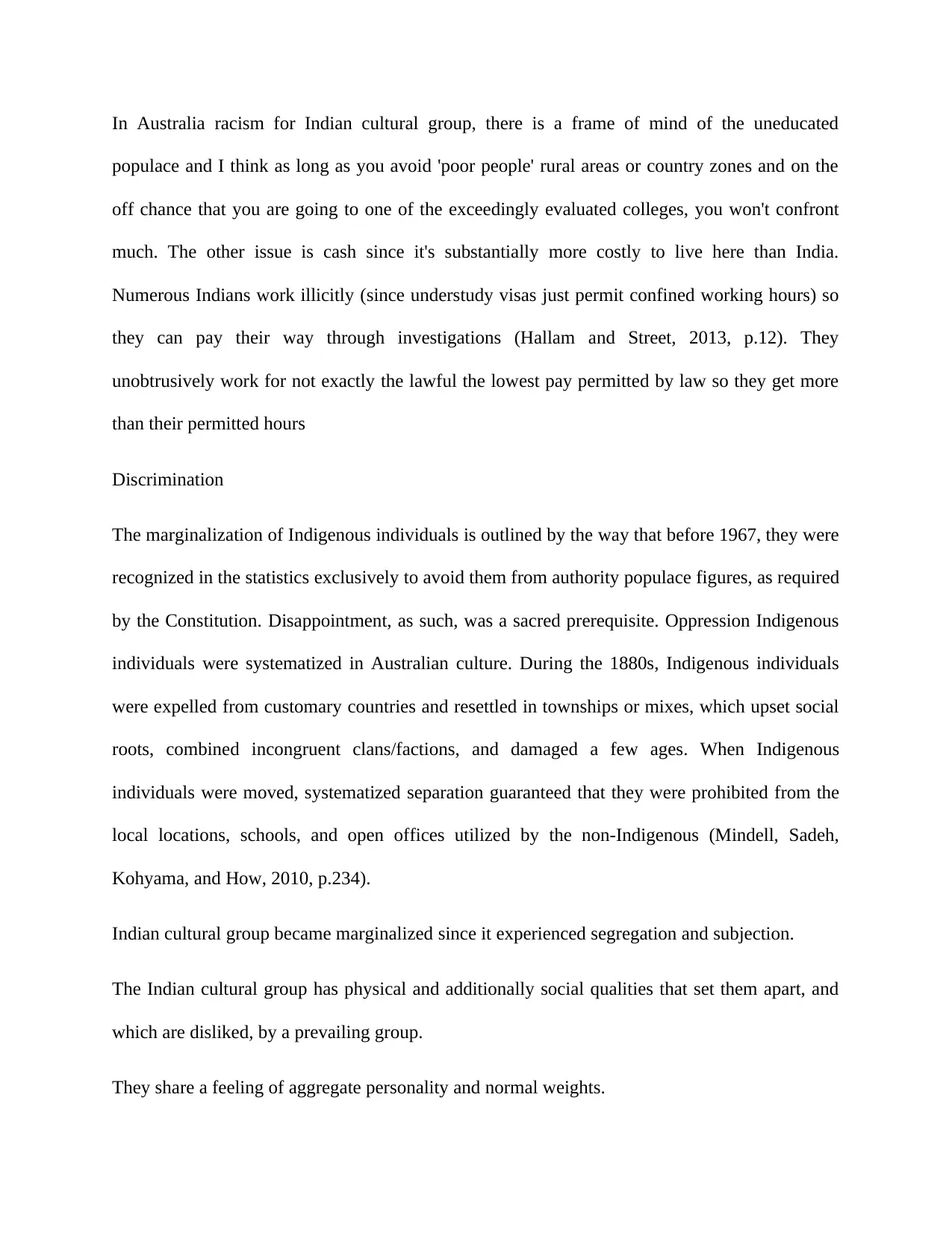
In Australia racism for Indian cultural group, there is a frame of mind of the uneducated
populace and I think as long as you avoid 'poor people' rural areas or country zones and on the
off chance that you are going to one of the exceedingly evaluated colleges, you won't confront
much. The other issue is cash since it's substantially more costly to live here than India.
Numerous Indians work illicitly (since understudy visas just permit confined working hours) so
they can pay their way through investigations (Hallam and Street, 2013, p.12). They
unobtrusively work for not exactly the lawful the lowest pay permitted by law so they get more
than their permitted hours
Discrimination
The marginalization of Indigenous individuals is outlined by the way that before 1967, they were
recognized in the statistics exclusively to avoid them from authority populace figures, as required
by the Constitution. Disappointment, as such, was a sacred prerequisite. Oppression Indigenous
individuals were systematized in Australian culture. During the 1880s, Indigenous individuals
were expelled from customary countries and resettled in townships or mixes, which upset social
roots, combined incongruent clans/factions, and damaged a few ages. When Indigenous
individuals were moved, systematized separation guaranteed that they were prohibited from the
local locations, schools, and open offices utilized by the non-Indigenous (Mindell, Sadeh,
Kohyama, and How, 2010, p.234).
Indian cultural group became marginalized since it experienced segregation and subjection.
The Indian cultural group has physical and additionally social qualities that set them apart, and
which are disliked, by a prevailing group.
They share a feeling of aggregate personality and normal weights.
populace and I think as long as you avoid 'poor people' rural areas or country zones and on the
off chance that you are going to one of the exceedingly evaluated colleges, you won't confront
much. The other issue is cash since it's substantially more costly to live here than India.
Numerous Indians work illicitly (since understudy visas just permit confined working hours) so
they can pay their way through investigations (Hallam and Street, 2013, p.12). They
unobtrusively work for not exactly the lawful the lowest pay permitted by law so they get more
than their permitted hours
Discrimination
The marginalization of Indigenous individuals is outlined by the way that before 1967, they were
recognized in the statistics exclusively to avoid them from authority populace figures, as required
by the Constitution. Disappointment, as such, was a sacred prerequisite. Oppression Indigenous
individuals were systematized in Australian culture. During the 1880s, Indigenous individuals
were expelled from customary countries and resettled in townships or mixes, which upset social
roots, combined incongruent clans/factions, and damaged a few ages. When Indigenous
individuals were moved, systematized separation guaranteed that they were prohibited from the
local locations, schools, and open offices utilized by the non-Indigenous (Mindell, Sadeh,
Kohyama, and How, 2010, p.234).
Indian cultural group became marginalized since it experienced segregation and subjection.
The Indian cultural group has physical and additionally social qualities that set them apart, and
which are disliked, by a prevailing group.
They share a feeling of aggregate personality and normal weights.

They have shared social guidelines about who has a place, and who does not.
They tend to wed within the group.
Other reasons for marginalization of this group is that The explanations behind the high
frequencies of poverty and hardship among the Indian group are to be found in their proceeding
with absence of access to salary acquiring capital resources (farming area and non-land
resources), overwhelming reliance on pay work, high joblessness, low education and different
components (Murphy, K. and Cherney, 2011, p.12).
What continues to perpetuate their marginalization in Australian Society?
The Indian cultural group in Australia continue to be highly marginalized because of the absence
of positive and steady connections implies that they are kept from taking an interest in local life,
which thus prompts further detachment. This tremendously affects the improvement of people,
just as on society on the loose.
As the goal of improvement is to make an empowering environment domain for individuals to
appreciate a gainful, sound, and innovative life, it is essential to address the issue of
marginalization. Advancement is in every case comprehensively considered as far as mass
cooperation. Minimization denies a vast lion's share of individuals over the globe from taking
part in the advancement. It is a mind-boggling issue, and there are numerous elements that bring
about the Indian marginalization. This mind-boggling and the significant issue should be tended
to at the arrangement level.
Thus there exist fewer laws in Australia which specifically prevent the further marginalization of
this Indian cultural group. There also still exist high rates of unemployment and racism. This
They tend to wed within the group.
Other reasons for marginalization of this group is that The explanations behind the high
frequencies of poverty and hardship among the Indian group are to be found in their proceeding
with absence of access to salary acquiring capital resources (farming area and non-land
resources), overwhelming reliance on pay work, high joblessness, low education and different
components (Murphy, K. and Cherney, 2011, p.12).
What continues to perpetuate their marginalization in Australian Society?
The Indian cultural group in Australia continue to be highly marginalized because of the absence
of positive and steady connections implies that they are kept from taking an interest in local life,
which thus prompts further detachment. This tremendously affects the improvement of people,
just as on society on the loose.
As the goal of improvement is to make an empowering environment domain for individuals to
appreciate a gainful, sound, and innovative life, it is essential to address the issue of
marginalization. Advancement is in every case comprehensively considered as far as mass
cooperation. Minimization denies a vast lion's share of individuals over the globe from taking
part in the advancement. It is a mind-boggling issue, and there are numerous elements that bring
about the Indian marginalization. This mind-boggling and the significant issue should be tended
to at the arrangement level.
Thus there exist fewer laws in Australia which specifically prevent the further marginalization of
this Indian cultural group. There also still exist high rates of unemployment and racism. This
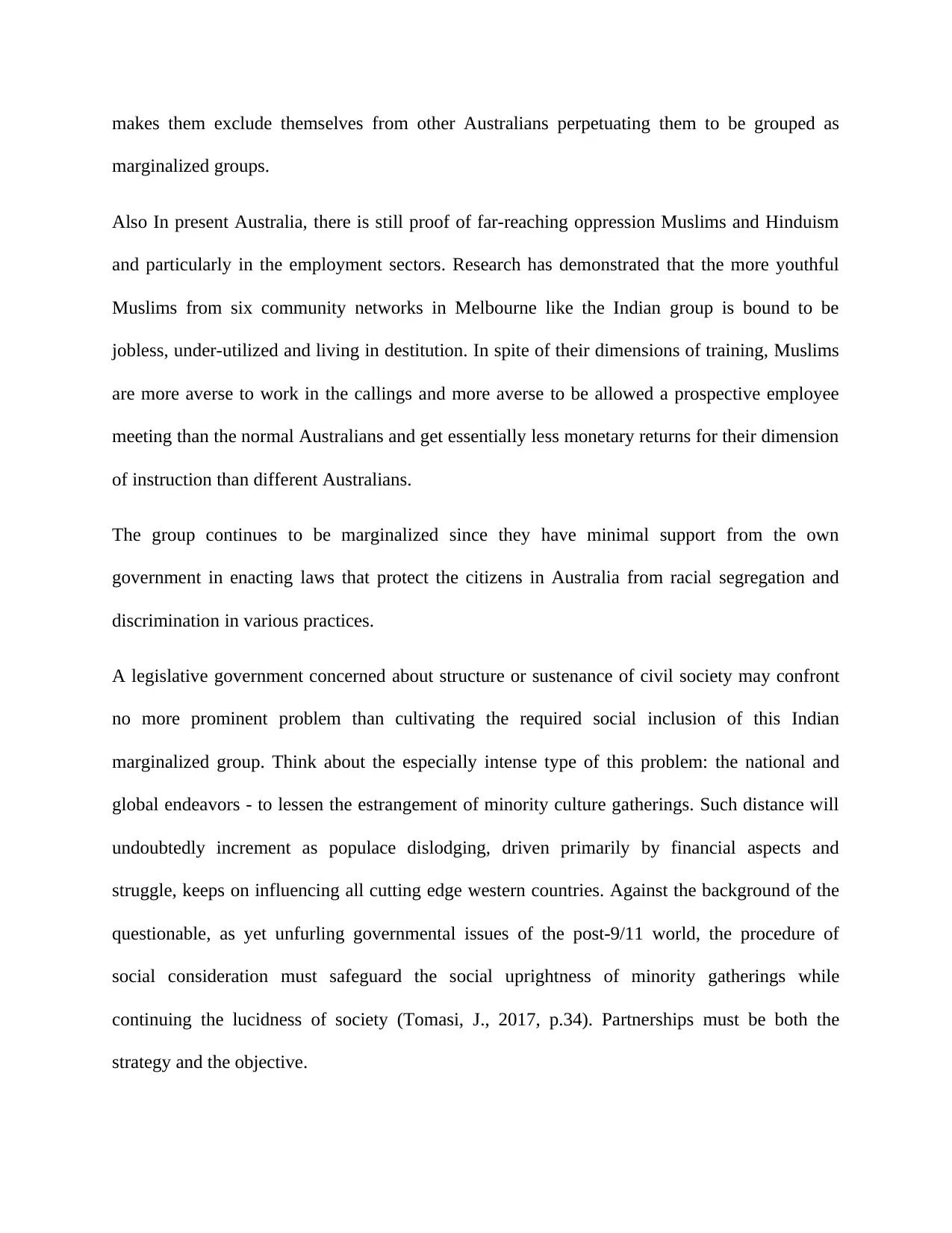
makes them exclude themselves from other Australians perpetuating them to be grouped as
marginalized groups.
Also In present Australia, there is still proof of far-reaching oppression Muslims and Hinduism
and particularly in the employment sectors. Research has demonstrated that the more youthful
Muslims from six community networks in Melbourne like the Indian group is bound to be
jobless, under-utilized and living in destitution. In spite of their dimensions of training, Muslims
are more averse to work in the callings and more averse to be allowed a prospective employee
meeting than the normal Australians and get essentially less monetary returns for their dimension
of instruction than different Australians.
The group continues to be marginalized since they have minimal support from the own
government in enacting laws that protect the citizens in Australia from racial segregation and
discrimination in various practices.
A legislative government concerned about structure or sustenance of civil society may confront
no more prominent problem than cultivating the required social inclusion of this Indian
marginalized group. Think about the especially intense type of this problem: the national and
global endeavors - to lessen the estrangement of minority culture gatherings. Such distance will
undoubtedly increment as populace dislodging, driven primarily by financial aspects and
struggle, keeps on influencing all cutting edge western countries. Against the background of the
questionable, as yet unfurling governmental issues of the post-9/11 world, the procedure of
social consideration must safeguard the social uprightness of minority gatherings while
continuing the lucidness of society (Tomasi, J., 2017, p.34). Partnerships must be both the
strategy and the objective.
marginalized groups.
Also In present Australia, there is still proof of far-reaching oppression Muslims and Hinduism
and particularly in the employment sectors. Research has demonstrated that the more youthful
Muslims from six community networks in Melbourne like the Indian group is bound to be
jobless, under-utilized and living in destitution. In spite of their dimensions of training, Muslims
are more averse to work in the callings and more averse to be allowed a prospective employee
meeting than the normal Australians and get essentially less monetary returns for their dimension
of instruction than different Australians.
The group continues to be marginalized since they have minimal support from the own
government in enacting laws that protect the citizens in Australia from racial segregation and
discrimination in various practices.
A legislative government concerned about structure or sustenance of civil society may confront
no more prominent problem than cultivating the required social inclusion of this Indian
marginalized group. Think about the especially intense type of this problem: the national and
global endeavors - to lessen the estrangement of minority culture gatherings. Such distance will
undoubtedly increment as populace dislodging, driven primarily by financial aspects and
struggle, keeps on influencing all cutting edge western countries. Against the background of the
questionable, as yet unfurling governmental issues of the post-9/11 world, the procedure of
social consideration must safeguard the social uprightness of minority gatherings while
continuing the lucidness of society (Tomasi, J., 2017, p.34). Partnerships must be both the
strategy and the objective.
Paraphrase This Document
Need a fresh take? Get an instant paraphrase of this document with our AI Paraphraser
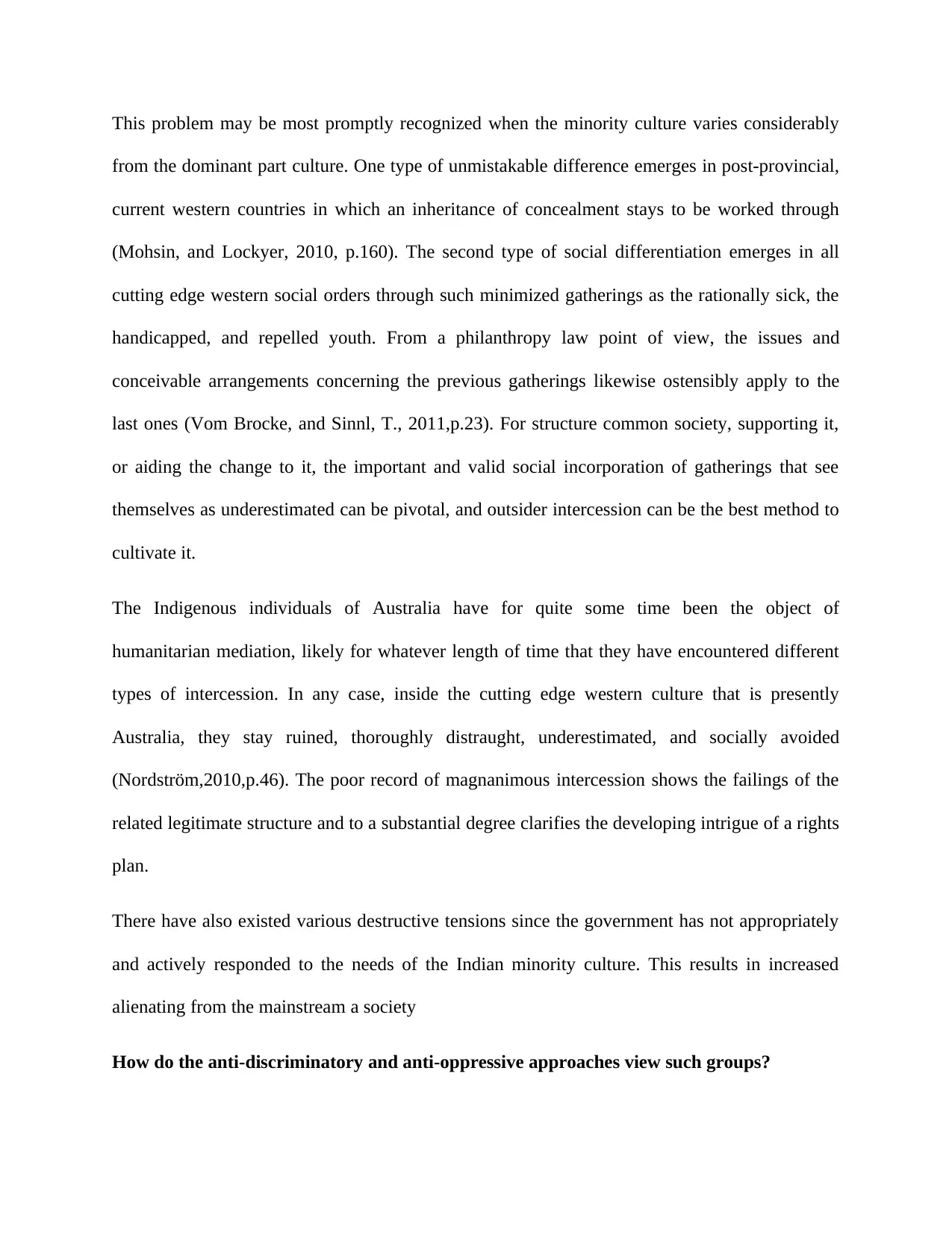
This problem may be most promptly recognized when the minority culture varies considerably
from the dominant part culture. One type of unmistakable difference emerges in post-provincial,
current western countries in which an inheritance of concealment stays to be worked through
(Mohsin, and Lockyer, 2010, p.160). The second type of social differentiation emerges in all
cutting edge western social orders through such minimized gatherings as the rationally sick, the
handicapped, and repelled youth. From a philanthropy law point of view, the issues and
conceivable arrangements concerning the previous gatherings likewise ostensibly apply to the
last ones (Vom Brocke, and Sinnl, T., 2011,p.23). For structure common society, supporting it,
or aiding the change to it, the important and valid social incorporation of gatherings that see
themselves as underestimated can be pivotal, and outsider intercession can be the best method to
cultivate it.
The Indigenous individuals of Australia have for quite some time been the object of
humanitarian mediation, likely for whatever length of time that they have encountered different
types of intercession. In any case, inside the cutting edge western culture that is presently
Australia, they stay ruined, thoroughly distraught, underestimated, and socially avoided
(Nordström,2010,p.46). The poor record of magnanimous intercession shows the failings of the
related legitimate structure and to a substantial degree clarifies the developing intrigue of a rights
plan.
There have also existed various destructive tensions since the government has not appropriately
and actively responded to the needs of the Indian minority culture. This results in increased
alienating from the mainstream a society
How do the anti-discriminatory and anti-oppressive approaches view such groups?
from the dominant part culture. One type of unmistakable difference emerges in post-provincial,
current western countries in which an inheritance of concealment stays to be worked through
(Mohsin, and Lockyer, 2010, p.160). The second type of social differentiation emerges in all
cutting edge western social orders through such minimized gatherings as the rationally sick, the
handicapped, and repelled youth. From a philanthropy law point of view, the issues and
conceivable arrangements concerning the previous gatherings likewise ostensibly apply to the
last ones (Vom Brocke, and Sinnl, T., 2011,p.23). For structure common society, supporting it,
or aiding the change to it, the important and valid social incorporation of gatherings that see
themselves as underestimated can be pivotal, and outsider intercession can be the best method to
cultivate it.
The Indigenous individuals of Australia have for quite some time been the object of
humanitarian mediation, likely for whatever length of time that they have encountered different
types of intercession. In any case, inside the cutting edge western culture that is presently
Australia, they stay ruined, thoroughly distraught, underestimated, and socially avoided
(Nordström,2010,p.46). The poor record of magnanimous intercession shows the failings of the
related legitimate structure and to a substantial degree clarifies the developing intrigue of a rights
plan.
There have also existed various destructive tensions since the government has not appropriately
and actively responded to the needs of the Indian minority culture. This results in increased
alienating from the mainstream a society
How do the anti-discriminatory and anti-oppressive approaches view such groups?
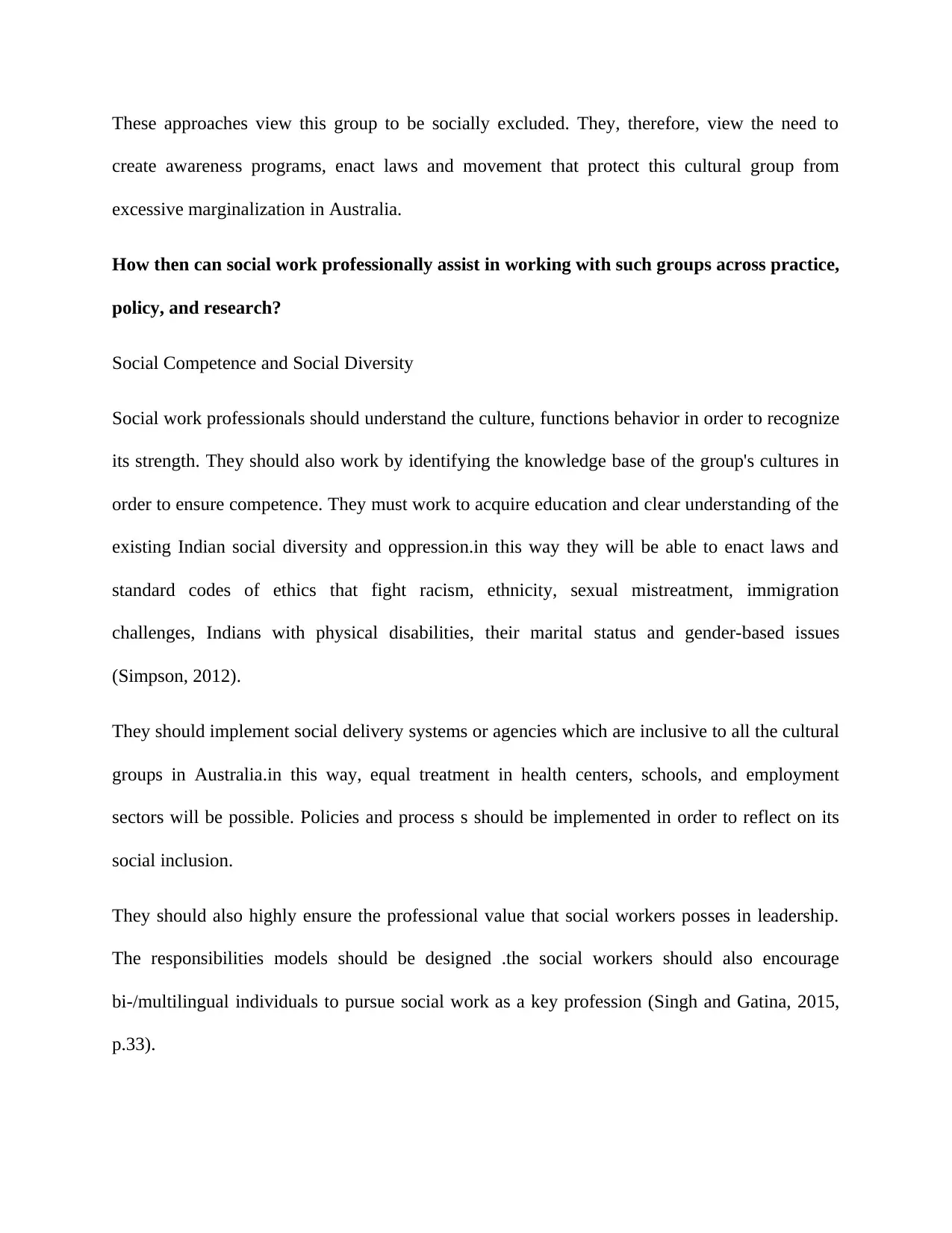
These approaches view this group to be socially excluded. They, therefore, view the need to
create awareness programs, enact laws and movement that protect this cultural group from
excessive marginalization in Australia.
How then can social work professionally assist in working with such groups across practice,
policy, and research?
Social Competence and Social Diversity
Social work professionals should understand the culture, functions behavior in order to recognize
its strength. They should also work by identifying the knowledge base of the group's cultures in
order to ensure competence. They must work to acquire education and clear understanding of the
existing Indian social diversity and oppression.in this way they will be able to enact laws and
standard codes of ethics that fight racism, ethnicity, sexual mistreatment, immigration
challenges, Indians with physical disabilities, their marital status and gender-based issues
(Simpson, 2012).
They should implement social delivery systems or agencies which are inclusive to all the cultural
groups in Australia.in this way, equal treatment in health centers, schools, and employment
sectors will be possible. Policies and process s should be implemented in order to reflect on its
social inclusion.
They should also highly ensure the professional value that social workers posses in leadership.
The responsibilities models should be designed .the social workers should also encourage
bi-/multilingual individuals to pursue social work as a key profession (Singh and Gatina, 2015,
p.33).
create awareness programs, enact laws and movement that protect this cultural group from
excessive marginalization in Australia.
How then can social work professionally assist in working with such groups across practice,
policy, and research?
Social Competence and Social Diversity
Social work professionals should understand the culture, functions behavior in order to recognize
its strength. They should also work by identifying the knowledge base of the group's cultures in
order to ensure competence. They must work to acquire education and clear understanding of the
existing Indian social diversity and oppression.in this way they will be able to enact laws and
standard codes of ethics that fight racism, ethnicity, sexual mistreatment, immigration
challenges, Indians with physical disabilities, their marital status and gender-based issues
(Simpson, 2012).
They should implement social delivery systems or agencies which are inclusive to all the cultural
groups in Australia.in this way, equal treatment in health centers, schools, and employment
sectors will be possible. Policies and process s should be implemented in order to reflect on its
social inclusion.
They should also highly ensure the professional value that social workers posses in leadership.
The responsibilities models should be designed .the social workers should also encourage
bi-/multilingual individuals to pursue social work as a key profession (Singh and Gatina, 2015,
p.33).
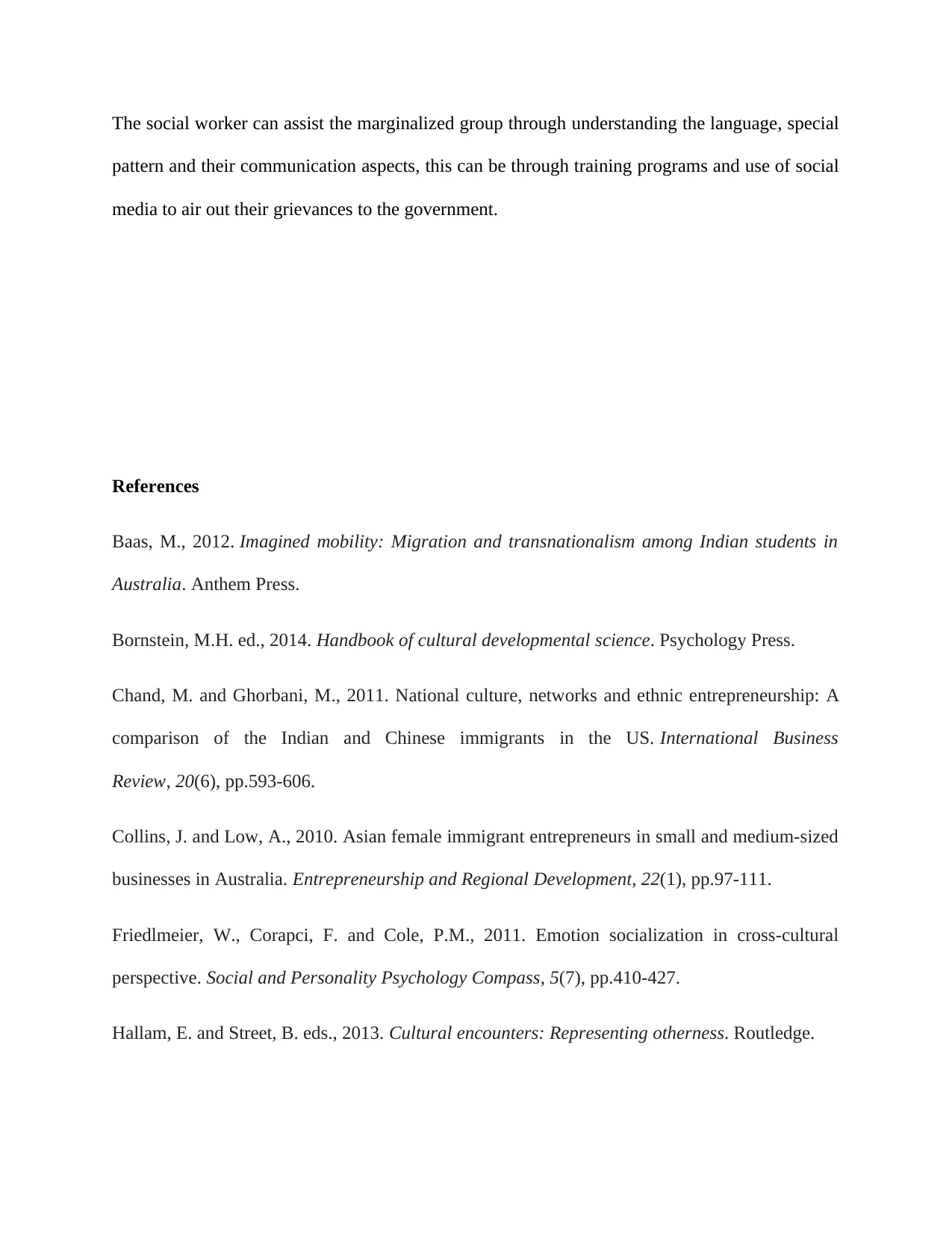
The social worker can assist the marginalized group through understanding the language, special
pattern and their communication aspects, this can be through training programs and use of social
media to air out their grievances to the government.
References
Baas, M., 2012. Imagined mobility: Migration and transnationalism among Indian students in
Australia. Anthem Press.
Bornstein, M.H. ed., 2014. Handbook of cultural developmental science. Psychology Press.
Chand, M. and Ghorbani, M., 2011. National culture, networks and ethnic entrepreneurship: A
comparison of the Indian and Chinese immigrants in the US. International Business
Review, 20(6), pp.593-606.
Collins, J. and Low, A., 2010. Asian female immigrant entrepreneurs in small and medium-sized
businesses in Australia. Entrepreneurship and Regional Development, 22(1), pp.97-111.
Friedlmeier, W., Corapci, F. and Cole, P.M., 2011. Emotion socialization in cross‐cultural
perspective. Social and Personality Psychology Compass, 5(7), pp.410-427.
Hallam, E. and Street, B. eds., 2013. Cultural encounters: Representing otherness. Routledge.
pattern and their communication aspects, this can be through training programs and use of social
media to air out their grievances to the government.
References
Baas, M., 2012. Imagined mobility: Migration and transnationalism among Indian students in
Australia. Anthem Press.
Bornstein, M.H. ed., 2014. Handbook of cultural developmental science. Psychology Press.
Chand, M. and Ghorbani, M., 2011. National culture, networks and ethnic entrepreneurship: A
comparison of the Indian and Chinese immigrants in the US. International Business
Review, 20(6), pp.593-606.
Collins, J. and Low, A., 2010. Asian female immigrant entrepreneurs in small and medium-sized
businesses in Australia. Entrepreneurship and Regional Development, 22(1), pp.97-111.
Friedlmeier, W., Corapci, F. and Cole, P.M., 2011. Emotion socialization in cross‐cultural
perspective. Social and Personality Psychology Compass, 5(7), pp.410-427.
Hallam, E. and Street, B. eds., 2013. Cultural encounters: Representing otherness. Routledge.
Secure Best Marks with AI Grader
Need help grading? Try our AI Grader for instant feedback on your assignments.
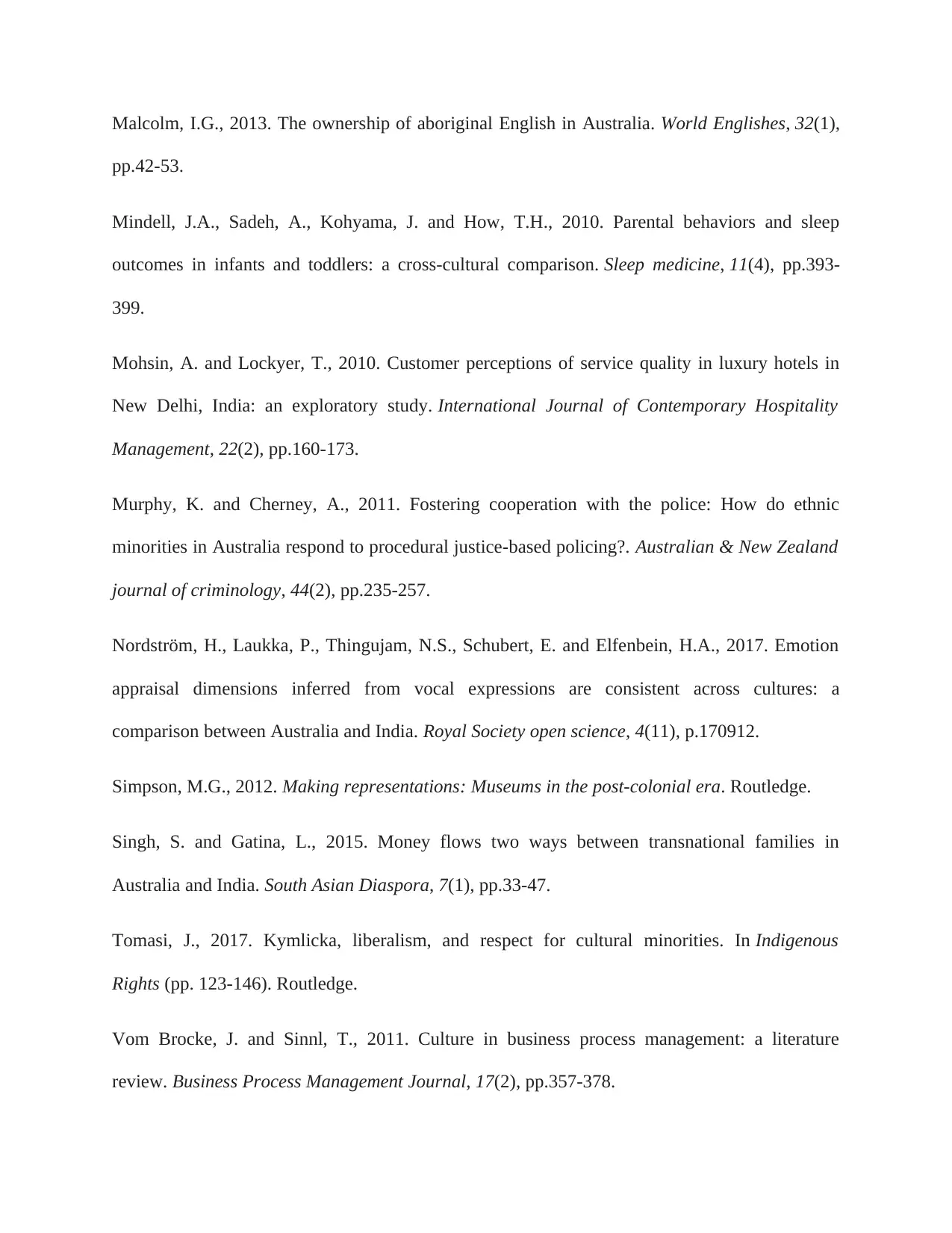
Malcolm, I.G., 2013. The ownership of aboriginal English in Australia. World Englishes, 32(1),
pp.42-53.
Mindell, J.A., Sadeh, A., Kohyama, J. and How, T.H., 2010. Parental behaviors and sleep
outcomes in infants and toddlers: a cross-cultural comparison. Sleep medicine, 11(4), pp.393-
399.
Mohsin, A. and Lockyer, T., 2010. Customer perceptions of service quality in luxury hotels in
New Delhi, India: an exploratory study. International Journal of Contemporary Hospitality
Management, 22(2), pp.160-173.
Murphy, K. and Cherney, A., 2011. Fostering cooperation with the police: How do ethnic
minorities in Australia respond to procedural justice-based policing?. Australian & New Zealand
journal of criminology, 44(2), pp.235-257.
Nordström, H., Laukka, P., Thingujam, N.S., Schubert, E. and Elfenbein, H.A., 2017. Emotion
appraisal dimensions inferred from vocal expressions are consistent across cultures: a
comparison between Australia and India. Royal Society open science, 4(11), p.170912.
Simpson, M.G., 2012. Making representations: Museums in the post-colonial era. Routledge.
Singh, S. and Gatina, L., 2015. Money flows two ways between transnational families in
Australia and India. South Asian Diaspora, 7(1), pp.33-47.
Tomasi, J., 2017. Kymlicka, liberalism, and respect for cultural minorities. In Indigenous
Rights (pp. 123-146). Routledge.
Vom Brocke, J. and Sinnl, T., 2011. Culture in business process management: a literature
review. Business Process Management Journal, 17(2), pp.357-378.
pp.42-53.
Mindell, J.A., Sadeh, A., Kohyama, J. and How, T.H., 2010. Parental behaviors and sleep
outcomes in infants and toddlers: a cross-cultural comparison. Sleep medicine, 11(4), pp.393-
399.
Mohsin, A. and Lockyer, T., 2010. Customer perceptions of service quality in luxury hotels in
New Delhi, India: an exploratory study. International Journal of Contemporary Hospitality
Management, 22(2), pp.160-173.
Murphy, K. and Cherney, A., 2011. Fostering cooperation with the police: How do ethnic
minorities in Australia respond to procedural justice-based policing?. Australian & New Zealand
journal of criminology, 44(2), pp.235-257.
Nordström, H., Laukka, P., Thingujam, N.S., Schubert, E. and Elfenbein, H.A., 2017. Emotion
appraisal dimensions inferred from vocal expressions are consistent across cultures: a
comparison between Australia and India. Royal Society open science, 4(11), p.170912.
Simpson, M.G., 2012. Making representations: Museums in the post-colonial era. Routledge.
Singh, S. and Gatina, L., 2015. Money flows two ways between transnational families in
Australia and India. South Asian Diaspora, 7(1), pp.33-47.
Tomasi, J., 2017. Kymlicka, liberalism, and respect for cultural minorities. In Indigenous
Rights (pp. 123-146). Routledge.
Vom Brocke, J. and Sinnl, T., 2011. Culture in business process management: a literature
review. Business Process Management Journal, 17(2), pp.357-378.

1 out of 12
Your All-in-One AI-Powered Toolkit for Academic Success.
+13062052269
info@desklib.com
Available 24*7 on WhatsApp / Email
![[object Object]](/_next/static/media/star-bottom.7253800d.svg)
Unlock your academic potential
© 2024 | Zucol Services PVT LTD | All rights reserved.